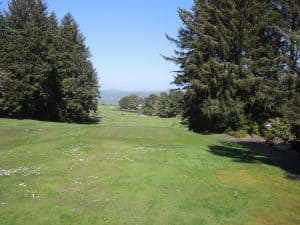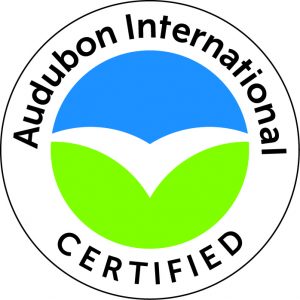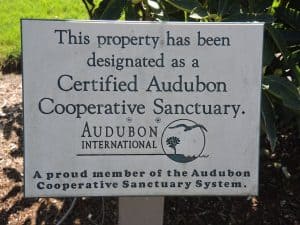In doing research for OregonCourses, I look into what each course is trying to do to benefit the local non-golf community. I found that pretty much every course in Oregon does some type of positive community outreach. Often, that positive outreach is in the category of improving the possible negative effects that a course might have on the environment and/or wildlife. In general, golf courses can have a very negative effect on the local environment through the application of chemicals and their disposal and run-off, use of water (especially on the east side of the Cascades where that resource is scarce), and disruption of wildlife habitat. On the other hand, golf courses have the capability of improving the local environment, especially in urban areas, by providing green spaces and wildlife habitat that might not otherwise exist.
The golf industry, especially the golf industry in Oregon, is generally mindful of these potential problems and opportunities. Several resources are available to courses to help them examine and then improve upon their environmental impact. These resources include resources and research from the national Environmental Institute for Golf, www.eifg.org, and more locally, from the Oregon Golf Course Superintendents’ Association through the Environmental Stewardship Guidelines, www.gcsaa.org/environment/environment-hub .
Another significant provider of resources to help improve environmental impacts from a golf course is Audubon International (“AI”), through the Audubon Cooperative Sanctuary Program for Golf Courses (“ACSP”). According to its website, the program “helps organizations and businesses protect our environment while enhancing their bottom line.” The program has had support from the USGA in $1.5 million in grant funding, most recently with the Monarch In The Rough initiative to provide habitat for monarch butterflies and similar pollinators. AI states that over 1,650 courses in the United States are ACSP members with about 850 courses being certified. But I have heard criticism by some golf superintendents that the program is too expensive and document intensive. The program was also the subject of a very negative article by Rachael Bale and Tom Knudson, The Other Audubon, that appeared in, among other things, the Fall 2015 edition of Links Magazine (the “Bale and Knudson Article”).
I enjoy being out on a golf course, even just walking. I am also a member of the local Audubon Society and support best environmental stewardship practices to retain and preserve natural spaces and other natural resources. I have also seen the AI signs on a few OregonCourses. I wanted to know if the ACSP actually helps the environment and, if so, how accessible was it to golf courses of all types.
As noted above, the ACSP is part of AI, a 501(c)(3) organization. AI is not, in any way, part of what folks would generally refer to as the Audubon Society (or more correctly, the National Audubon Society) or any of its local chapters, including several chapters in Oregon. When AI started in 1987 (the ACSP started in 1991), the founders of AI (which included a former executive of the National Audubon Society) were able to resurrect a dormant New York State business registration under the Audubon International name. The National Audubon Society sued to stop AI’s usage of the “Audubon” name, but was unsuccessful. On its website, AI is upfront with the fact that it is not related to the National Audubon Society. But confusion of the relationship between the entities continues.
AI states that it encourages golf courses to address adverse environmental effects of golf courses and their operations through environmental education and certification programs. In Oregon, two types of certifications have been granted. The Signature Program is for the planning and construction of a new golf course. This program is very extensive and expensive, and will not be discussed here except to note that there is only one course in Oregon that has been certified to be an Audubon International Signature Sanctuary Course: Tetherow Golf Club.
The primary program for existing courses is the ACSP certification program. To become ACSP certified, a course has to go through the following:
1. Pay a fee and become a member of the program (very simple; you can do it on line). In return, the course receives from AI a Guide to Environmental Stewardship on the Golf Course, a Certification Handbook, and materials on the regional ecological community and native plant information.
2. The course then prepares a Site Assessment and Environmental Plan, which may, depending on the course, identify possible environmental liabilities to both people and the environment. No testing or monitoring is required for this assessment. The Environmental Plan is unique to the course’s operations and settings, and must contain a strategy to improve management and operations in five different categories: environmental planning, wildlife and habitat management, chemical use reduction and safety, water quality, and outreach and education. Although the plan is unique to each course, the plan must be centered on improving environmental practices and programs in each of these categories, adhering to best practices where available. The course must also designate a Resource Advisory Group that should include staff, golfers, neighbors, and local environmental experts. Once the plan is completed, it is submitted to AI for review and approval.
3. If AI approves the Environmental Plan, the course then implements the plan and documents its efforts. The course has to show that it is meeting its goals in each of the five different categories before it can be considered for a site visit by AI.
4. AI performs a course visit and records review. If AI determines that the goals in the five different categories are being achieved, the course becomes certified.
The fees paid to AI are $300 per year, plus the cost of a site visit ($400 plus travel, which can be shared with another course being visited). Although site visits used to be done by local conservation organizations (a site visit for Heron Lakes was done by a member of the Columbia Slough Watershed Council), AI found that this caused inconsistency in how standards were applied, and now site visits are only done by AI employees. Re-certification occurs every three years with a document review, and then in the sixth year with another course visit.
The primary cost is not in the fees; it is in the time needed to do the inventories, measurements, and documentation, as well as the cost of putting a plan in place. Documentation includes inventory of bird and mammal species, course maps showing naturalized areas and no-spray zones, an integrated pest management plan, reference charts showing chemical use and water quality for each water body on the course, and soil and water- testing results. There can also be significant program costs to put a plan in place. Although an ACSP plan should be unique to each course, there are some base requirements, such as reducing chemical use, reducing turf areas and having a natural habitat in at least 50 percent of minimally used areas, having at least 80 percent of landscaped areas covered with native species of flora, and upgrading irrigation systems to provide efficiency. Accordingly, the cost of plan implementation may include installing and maintaining an efficient irrigation system, installing detention ponds to collect run-off, planting native species, and taking the steps needed to implement an Integrated Pest Management Program. AI, however, will take a course’s financial consideration into account when accepting a plan, and certification can occur before complete steps (such as irrigation system replacement) are taken, as long as progress towards the goals are being achieved and such progress steps are set forth in the plan.
AI argues that these costs can be offset by the following benefits: reduced operating costs through greater efficiencies (including reduced waste) and lower insurance rates, improved image and reputation, and better golfer and employee satisfaction. AI also argues that achieving the certificate is good publicity, but is silent as to whether participation causes an increase in players.
Bale and Knudson Article
The Bale and Knudson Article made essentially three points. First, that AI’s use of the “Audubon” name was misleading and inappropriate. This is discussed above (it is confusing, but AI does try to distance itself from the National Audubon Society). Second, the article suggests that because AI is primarily funded through golf courses, golf courses are essentially rewarding themselves as environmental stewards even though they may not be requiring courses to adhere to the best practices. AI states that 55 percent of its income comes from fees from golf courses and that USGA does not provide funding for general operations, but may for special projects. In discussing the ACSP program with AI and several Oregon golf course managers/superintendents, it appears that AI acts independently from Oregon golf courses (and vice versa), and that the courses were using the ACSP and information provided by AI to improve practices.
The third point made by the article involved a certified course in central California that was killing waterfowl, in particular Coots, that were harming the course. The issue is, how could anything named Audubon allow the killing of birds? Frank LaVardera, Director of Environmental Programs for Golf at AI, stated that AI would encourage a course to use nonlethal means to deal with any wildlife that may be harming a course (and would provide examples of nonlethal means) and to consult with state wildlife officials to discuss possible methods of control. But if a certified course is acting within its plan and not violating any law, AI would not take any action against the course for killing wildlife. It does seem contradictory, however, for AI to ask a course to increase wildlife habitat, but then not take any action for the reduction of wildlife that is attracted to newly established or expanded wildlife areas. Guidelines for plans do suggest practices to prevent golfers from disturbing natural habitats and leaving nests and dens in place, but there is no stated guideline pertaining to wildlife “pest” management.
There are over 200 Oregon Courses. As of the Spring of 2020, there were 18 ACSP certified courses or course complexes in Oregon: The Oregon Golf Club, Shadow Hills Country Club, Widgi Creek, Bandon Trails (with Bandon Preserve), Bandon Dunes (with Pacific Dunes), Old Macdonald, OGA Golf Course, RiverRidge Golf Course, Juniper Ridge Golf Course, Glendoveer Golf Courses (both courses), Salishan Golf Course, Pumpkin Ridge (both courses), Eastmoreland Golf Course, Tualatin Country Club, Heron Lakes (both courses), Crosswater Golf Club, and Stone Creek Country Club. (ACSP certifies as one entity all courses and operations that share the same maintenance facility.) If you look at the list of participating courses, you will see that almost all are private courses, high-end public courses, or municipal courses. Only RiverRidge is not an 18-hole course (but was when initially certified).
The majority of OregonCourses are family-owned neighborhood courses, with many being 9-hole courses. I assumed that the cost of implementing a plan to be certified was the primary reason why these types of courses did not participate in the program. But in talking with several course owner/operators (not really a survey; more anecdotal), the main reason why they did not participate was because they either did not know about the program at all or knew very little about the program. For some courses that knew of the program, they believed that they already followed proper practices to limit environmental impacts and don’t need to pay a nonprofit to participate in a program that they perceived as not providing any additional benefit.
In discussing the ACSP program with managers/superintendents from several certified OregonCourses (again, not a survey), most said that they did not experience any real increase in expenses or any significant detriment in participating in the program and becoming certified. Some did note, however, that there was an increase in documentation and testing. All stated that they have no evidence that participation in the program increased the number of rounds/players or otherwise provided any direct economic benefit. (Although one pro thought that there is a group of golfers who target certified courses to play.) Some courses did publicize the award of a certificate to promote their course. The courses also stated that participation in the program helped to improve the image of the course and public awareness of what a course is doing. But the main benefit noted by these OregonCourses was that the program and the information provided by AI to improve course operations helped to sharpen a course’s operations’ practices to minimize adverse environmental effects.
Does ACSP Help?

Does the Certified Audubon Cooperative Sanctuary Program for Golf Courses help the environment? Probably a little bit through the sharing of information on best practices and having course operations focus on the issue of how course operations impact the environment. But probably not a lot. The OregonCourses that are certified were already concerned with how operations impacted the environment and probably would have taken measures to mitigate that impact with or without the program.
Does participation in the ACSP provide tangible benefits to the OregonCourses that are certified? Probably a little. Courses have experienced a bump in publicity (but not play) and there may be a slight reduction in operating costs once the plan is in place, but this may be offset by a slight increase in program costs, primarily through an increase in testing and documentation.
Is the ACSP accessible for golf courses? Yes and no. If a course is already mindful of trying to limit the environmental impact of course operations, then yes. But that’s the rub. I would think that the ACSP would provide the greatest help for the environment if courses that had poor or nonexistent efforts to limit adverse environmental effects from course operations participated in the program. But those courses would probably incur the greatest costs in getting certified and probably have the least amount of revenue to participate.
Is the ACSP an overall good thing? Even with some shortfalls, I believe that yes, it is. Primarily because ACSP causes a course to focus on its environmental impact and providing information on what can be done to lessen it. I believe that the program’s impact could improve and be expanded if AI (or, even better, the USGA) provided greater advertising of certified courses and the positive steps they are doing, and if AI offered grants or no/low interest loans for courses without a lot of revenue to participate in the program.
None of this is to say that if a course is not participating in the ACSP that it is not mindful of a course’s environmental impact. Some of the OregonCourses with the most aggressive mitigation programs are not ACSP members: e.g., Laurelwood, Hidden Valley, and the Sunriver courses. But as a golfer who also appreciates nature, if a course is certified, I know that the course is paying attention to helping nature. And that will make my round slightly more enjoyable.
Prior Articles and Interviews please e-mail [email protected] if you would like to view any of the Prior Articles and Interviews:
Oregon Golf in the Age of COVID-19
The Highest Golf Course In Oregon
Earliest Golf Courses in Central Oregon
Submit your review | |
Excellent and helpful review. It feels like you did your best to be unbiased. I appreciate your effort.




